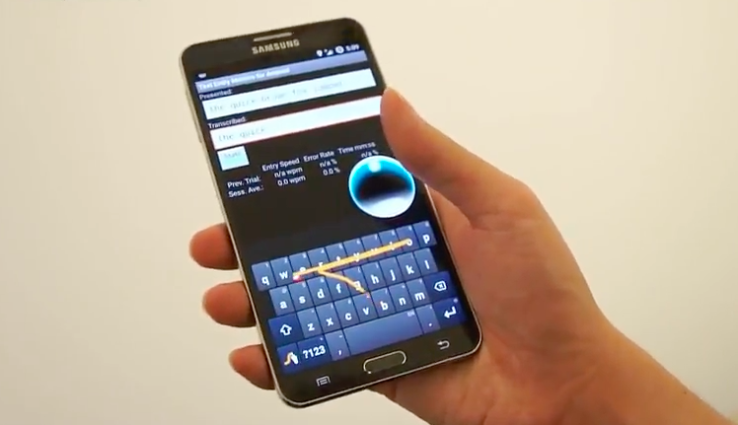

Keyboard nerds like me could become a dying breed if the voice-controlled future accelerates at us quite as quickly as companies like Alexa-owning Amazon hope. But in the interim, with screens still loitering in the orbits of our fingertips, texting remains the done thing (well, not counting kids who prefer recording voice messages to send to each others’ messaging apps — I know, I know, path of least resistance and all that…).
Meanwhile, there are more types and growing numbers of computing devices in play than ever before, from wearables to VR headsets, so interface researchers are finding additional reasons to optimize keyboard-based usability kinks.
To wit: a group of researchers, led by postgraduate student Hui-Shyong Yeo at the University of St Andrews, has come up with a tilt-based typing technique designed — at first glance — to be an alternative for users of larger smartphones (phablets) or tablets; to enable one-handed typing, i.e. when your palm won’t easily stretch across the full span of glass. And many a cracked smartphone screen can surely be blamed on an unfortunate typing accident.
The researchers have called their tilt-based entry keyboard SWiM for short: aka ‘Shape Writing in Motion’. The core text entry technique is akin to gesture-based keyboards like Swype, where users use fingers to trace patterns over the keys to spell out words. (Indeed, they utilized Swype’s interface for this portion of the tech.) But the twist is SWiM users tilt the device with their dominant wrist to form the shades needed to form the words. So no finger-dragging necessary, just a little wrist dexterity.
“The dominant hand typically exhibits finer temporal and spatial resolutions,” they write in a research paper detailing the study, which also specifies that their technique only relies on pitch and roll for text input, as “the dexterity of yaw using one’s hand is very limited”.
“Our tilt-based technique allows one-handed text entry and also lends itself as a suitable text entry method for remote controllers, wearable devices, and for virtual reality text entry, where users cannot see the keyboard input device,” they add.
The researchers found that first time users who tested the tilt-based input system as part of the study were able to achieve a rate of 15 words per minute after “minimal practice”, and a rate of 32 wpm after around 90 minutes of practice.
To begin and end words using the tilt method — which utilizes accelerometer/gyroscope tech embedded into modern mobiles — the researchers came up with an additional on-screen button they call the “chat head”. This is a semi translucent bubble-like object that can be user-positioned on the screen. To type using SWiM the user taps on the chat head to start forming a word via tilting a pointer ball over the keys, before tapping a second time on the chat head to complete a word (which also inserts a space).
The chat head also supports gestures such as a left or right swipe which can be used for other gesture-based functions — such as deleting a word from the suggestions bar above the keyboard. Words can also be selected from the suggestions bar via tilting the pointer to a suggested word and short clicking on the chat head.
In the paper, the researchers describe SWiM as “fast and easy to learn compared to many existing single-handed text entry techniques”. The study involved a small number of participants conducting a transcription and a composition task using the technique (and also comparing their input to their standard typing and standard shape writing).
The study also looked at performance improvement over time via a longitudinal pilot with one participant who took part in six separate typing sessions — their SWiM entry rate rose from 15.60wpm during the first session to 32.18wpm by the sixth; an improvement rate of 106.3 per cent; also a much larger gain at the end of all the sessions than for normal typing (22.8%) and normal shape writing (29.5%).
Tilt as an input method for typing has been considered before — not least as a spoof option by SwiftKey for a 2013 April Fools joke — but experiments have yet to turn into any extended commercial rollouts. Yet as computing shifts into more types of devices — including those with very small screens or screens that can’t easily be touched — the need for alternative and/or supplementary input methods does, arguably, step up.
The researchers especially see potential for the technique to be useful in VR. “We believe our technique to be well suited for input in virtual reality (VR) applications. When wearing a VR headset, the user often cannot see the keyboard. Thus, a simple controller that supports tilt (e.g., Google VR controller, Oculus Touch) can use SWiM for text input,” they write, adding: “Our studies show that the technique has high immediate efficacy and is reasonably fast.”
Their first next step will be to release an installable version of the keyboard for users of touchscreen devices. “In the future, we plan to integrate our technique with a gesture keyboard and release it as an installable touchscreen keyboard application,” they write.
“We will continue to investigate which factors affect tilt-based shape writing and hope to improve SWiM over time. Lastly, we aim to use this technique on other devices, such as smartwatches, digital pendants, and head-mounted displays (HMD), which already have built-in tilt sensors.”
The research paper, entitled ‘Investigating tilt-based gesture keyboard entry for single-handed text entry on large devices’, will be published by the ACM SIGCHI in the upcoming Proceedings of the 2017 CHI Conference on Human Factors in Computing Systems.

